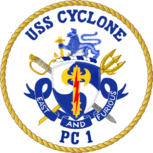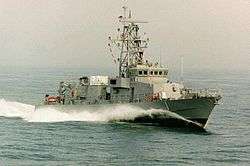BRP General Mariano Alvarez (PS-38)
 BRP General Mariano Alvarez (PS-38) | |
| History | |
|---|---|
| Name: | USS Cyclone |
| Awarded: | 1 August 1990 |
| Builder: | Bollinger Shipyards, Lockport, Louisiana |
| Cost: | US$25.69 million |
| Laid down: | 22 June 1991 |
| Launched: | 1 February 1992 |
| Commissioned: | 7 August 1993 |
| Decommissioned: | 28 February 2000 |
| Struck: | 28 February 2000 |
| Motto: | Fast and Furious |
| Fate: | Transferred to the U.S. Coast Guard on 29 February 2000. Transferred to Philippine Navy in 2004.[1] |
| Badge: |
 |
| Name: | General Mariano Alvarez |
| Namesake: | Mariano Álvarez (1818 – 1924) was a Filipino general and politician. An ally of Andres Bonifacio, he was designated Second Supremo of the Katipunan during the Philippine Revolution. |
| Operator: | Philippine Navy |
| Acquired: | January 2004[2] |
| Commissioned: | 8 March 2004[3] |
| Status: | In service |
| General characteristics | |
| Class and type: | Mariano Alvarez class |
| Type: | Coastal Patrol Vessel |
| Displacement: | 357 tons full load |
| Length: | 170.3 ft (51.9 m) |
| Beam: | 25.9 ft (7.9 m) |
| Draft: | 7.9 ft (2.4 m) |
| Installed power: | 13,400 hp (10,000 kW) |
| Propulsion: | 4 × Paxman Valenta 16V RP-200CM Diesel Engines, 4 propellers |
| Speed: | 35 knots (65 km/h; 40 mph) (maximum) |
| Range: | 2,900 mi (2,500 nmi; 4,700 km)at 12 knots (22 km/h; 14 mph) |
| Endurance: | 10 days |
| Boats & landing craft carried: | 1 × 20-foot RHIB |
| Complement: | 28 + 8 |
| Sensors and processing systems: |
|
| Electronic warfare & decoys: |
|
| Armament: | |
The BRP General Mariano Alvarez (PS-38) is the lone ship of the same class of coastal patrol ships in service with the Philippine Navy. Historically, she is the lead ship of the Cyclone class (a class of U.S. Navy patrol ships) prior to being transferred to the Philippine Navy, thereby making it the only navy other than the US Navy to operate a Cyclone-class ship. Today she is considered as one of the newest active fighting ships in the Philippine Navy.
History

Launched as the first of fourteen ships of Cyclone class patrol ships, the primary mission of the Cyclone was to serve as a platform for conducting maritime special operations, including interdiction, escort, noncombatant evacuation, reconnaissance, operational deception, intelligence collection, and tactical swimmer operations. Her small size, stealthy construction and high speed were tailored to performing long-range Special Operations Forces (SOF) insertion and extraction as well as other SOF support duties as needed.

As good a design as it is, the Cyclone had barely gone into service in the mid-1990s when the Special Operations Command rejected them as too big for commando missions, and the regular surface Navy dismissed them as too small for any of its missions. The Navy began looking for ways to phase out the Cyclone and her sister ships, so on 28 February 2000, the Cyclone was decommissioned and stricken from the Navy list.
It was then transferred to the United States Coast Guard the next day, being re-commissioned as the USCGC Cyclone (WPC-1). The Coast Guard lacked an effective vessel sized between its 110' patrol cutter and the 210' Medium Endurance Cutter, so there was considerable interest in Cyclone at first. However, her high operating costs were prohibitive and thus she sat largely inactive.
Cyclone was eventually sold under FMS to the Philippine Navy in January 2004, as part of a US military aid package to the Philippines, in an effort to bolster interdiction and counterterrorism capabilities. She was rechristened BRP General Mariano Alvarez (PS-38) on 8 March 2004, in honor of a revolutionary general in the Philippine war of independence against Spain.[4] She is currently assigned to the Patrol Force of the Philippine Fleet.[5]
On March 13, 2013 while she was conducting maritime patrol together with BRP Jose Andrada along the seawater off Omapoy Island and Bulo-Bulo Island, all of Sitangkai, Tawi-Tawi, they intercepted 2 watercraft loaded with 35 evacuees.[6]
She was also one of the naval vessels that was deployed to Zamboanga City during the Zamboanga City crisis.[7]
Technical details
Performance
The ship's operational capabilities were designed to meet the unique requirements of its Special Warfare missions. Operationally, the ship is capable of accelerating from stop to 35 knots (65 km/h) in under three minutes, then move from full ahead to 15 knots (28 km/h) astern in 60 seconds. In high-speed, hard-over turns, the ship barely heeled as the automatic stabilizers engaged.
Weapons
Originally armed with two Mk38 25 mm chain guns fore and aft, several pintle mounts for attaching .50 caliber machine guns or Mk 19 grenade launchers, and a position for launching Stinger shoulder-fired SAMs (although this was removed when the ship was transferred to the Philippine Navy and is currently unavailable), the ship, along with others of her class still in the US Navy, were upgraded early on by replacing the after Mk.38 mount with the new Mk.96 platform. The Mk.96 combines both a M242 Bushmaster 25 mm chain gun and a 40 mm automatic grenade launcher on a single stabilized platform. The Mk.96 features an electro-optical fire control system with 27x zoom, infrared and low-light modes, a laser rangefinder, and an array of environmental sensors, which feed data into the ballistics computer to produce an accurate firing solution even while maneuvering at high speed. The computer can also interface with Stinger SAMs (which are currently unavailable).[8] The US Navy was positive about the performance of the Mk.96 and briefly considered up-gunning the 25 mm Bushmaster cannon to a 30 mm or even 35 mm cannon, but due to the high price this never came to pass.[4]
Sensors
The Sperry Vision 2100M combat system employs the navigational radars and the Sperry Voyage Management System integrated navigation and control system as a combat data suite. The radar intercept equipment was developed for use on helicopters. Has a Sperry Marine automated Integrated Bridge System (IBS).Each Mk 52 decoy rocket launcher carries 12 ready-service rounds, and 15 more rockets per launcher are carried in adjacent lockers. Ammunition supply includes 2,000 rounds 25-mm, 2,000 rounds .50 cal, 2,000 rounds 7.62-mm, and 1,000 40-mm grenades.[8][9][10]
Navigation systems include Global Positioning System and Loran receivers. Radio gear includes LST-5C SATCOM/line-of-sight UHF transceiver, A5 Spectra VHF radio, ICM120 Marine Band radio, and RF 5000 HF, VRC-92A VHF, and VRC-83(V)2 VHF/UHF transceivers. AN/SAT-2A infrared signaling systems are fitted, and the Marconi Vistar stabilized FLIR sensor with integral low-light-level television camera is mounted on the mast. Have IFF transponder but no interrogation capability, although it may be added later. The sonar transducer is retracted within the hull at speeds above 14 kts.[8][8][9][10]
Structure
The hull was constructed using BS-4360 Grade 43A steel, the superstructure was constructed using 5086 aluminum alloy. Main propulsion is generated by four Paxman Valenta 16CM-16RP200M diesels, developing 3,350 bhp, driving 12.8 cm six-blade highly skewed, variable pitch and rake, NI-AL bronze MIL-B24480A, alloy 1 amendment 3 (nickel-aluminum-bronze alloy) propellers, with pitch ratio of 1.465 at 0.7 radius and designed by USN NSWCCD (Code 544 drawing number P-5237B). Four Reintjes WVS-2232 reduction gearbox, with a reduction ratio: 2.025:1. Fuel capacity is 47,772 liters (12,620 gallons). Oil capacity is 568 liters (150 gallons). Total air conditioning plants production, 83.33 kW. They can refuel at sea, using astern fueling rigs. Fully operational at Sea State 3 with cruising speed of 25 knots (46 km/h; 29 mph), with 50% fuel capacity. Ship can survive up to Sea State 5. Maximum ship endurance at 10 days. Electricity supplied by two Caterpillar Model 3306 DIT Series B, rating 150 kW @ 1,800 rpm. Reverse osmosis desalinators, having a 1,514 liters (400 gallons) capacity per day. Fresh water capacity is 4,701 liters (1,242 gallons).[8][10] Equipped with Vosper fin stabilization system and a stern wedge to improve trim at high speeds.[9] Kevlar armor is fitted to the command space.[8]
Upgrades
Refitted by Bollinger Machine Shop and Shipyard prior to delivery[2] and received a stern ramp modification upgrade known as the Combat Craft Retrieval System (CCRS) which had the ship's stern extended by nine feet to accommodate a deck ramp - which extends down to below the water line, for a 20 feet Rigid Hull Inflatable Boat (RHIB).[9]
References
- ↑ NavSource Online: Patrol Craft Coastal Photo Archive. USS Cyclone (PC-1).
- 1 2 3 Saunders, Stephen: Jane's Fighting Ships 107th Edition 2004-2005. Jane's Information Group Ltd, 2004.
- 1 2 3 4 5 "President Gloria Macapagal-Arroyo Speech on Commissioning of BRP Gen. Mariano Alvarez (PS-38) March 8, 2004". Office of the Press Secretary, Republic of the Philippines. 2004-03-08. Retrieved 2011-11-10.
- 1 2 Wikipedia. USS Cyclone (PC-1).
- ↑ Philippine Fleet Official Website. Commissioned ships and crafts.
- ↑ http://www.afp.mil.ph/index.php/19-afp-data-articles/latest-news/1117-afp-mobilizes-assets-to-aid-in-governments-humanitarian-efforts
- ↑ "Commander, NTG-61 send-offs PS38". ZamboTimes.
- 1 2 3 4 5 6 "PC-1 Cyclone class". GlobalSecurity.org. Retrieved 2011-11-10.
- 1 2 3 4 Wertheim, Eric: The Naval Institute Guide to Combat Fleets of the World 15th Edition, page 550. Naval Institute Press, 2007.
- 1 2 3 "PN Capital Ships". AFP Materiel Technical Specification Archives. Retrieved 2011-11-10.
External links
- The Official Website of BRP General Mariano Alvarez (PS-38)
- Philippine Navy Official website
- Philippine Fleet Official Website
- Philippine Defense Forum
- Hazegray World Navies Today: Philippines
- World Warships
- Naming and Code Designation of PN Ships